Taxation Law: Australia's Black, Sharing Economy, and Business
VerifiedAdded on 2021/02/20
|10
|2739
|31
Report
AI Summary
This report provides an in-depth analysis of taxation law, focusing on the black economy and the sharing economy within the Australian context. It defines these concepts and explores their implications on businesses. The report examines two contrasting business models: Woolworths Supermarkets, representing a traditional business structure, and Amazon, representing the sharing economy. It details their business structures, operational methods, and key differences that influence taxation outcomes. The report further explains the tax consequences of these differences under existing Australian tax law, including company tax, capital gains tax, and goods and services tax. It highlights how the Australian Income Tax law applies to participants in the sharing economy and discusses the tax implications for both traditional and sharing economy models. The report emphasizes the importance of understanding tax regulations and the implications of different business structures on tax liabilities.

TAXATION LAW
Paraphrase This Document
Need a fresh take? Get an instant paraphrase of this document with our AI Paraphraser
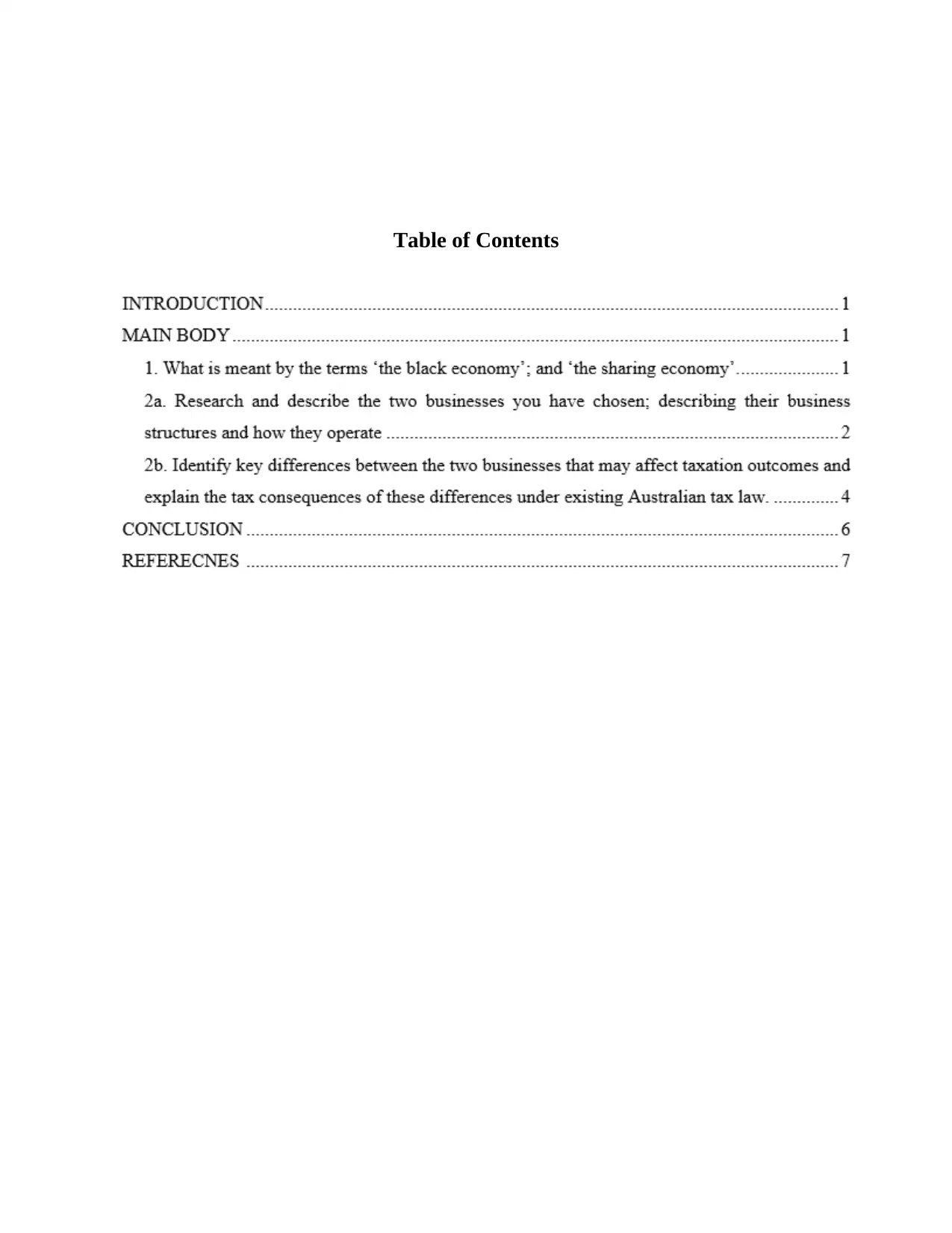
Table of Contents
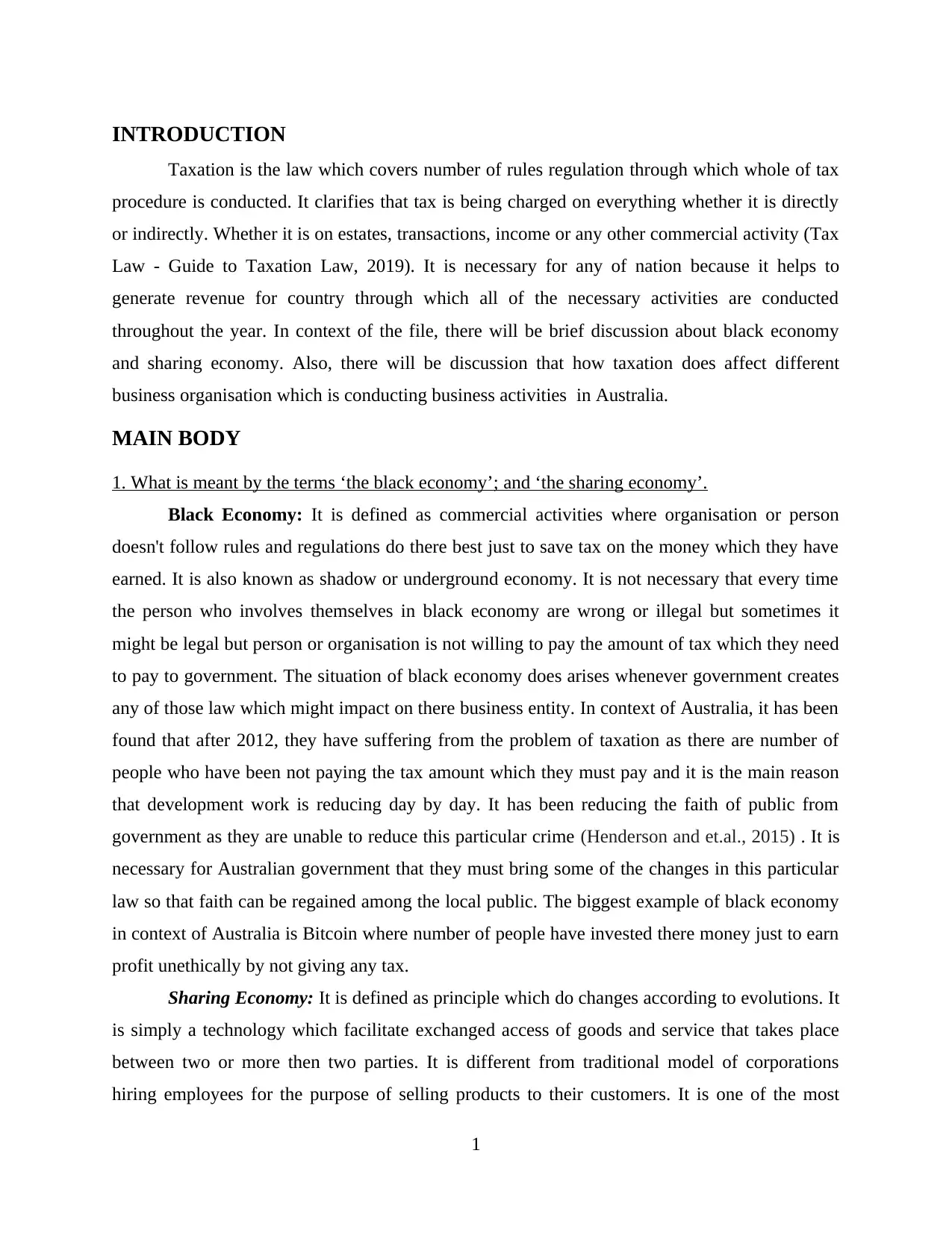
INTRODUCTION
Taxation is the law which covers number of rules regulation through which whole of tax
procedure is conducted. It clarifies that tax is being charged on everything whether it is directly
or indirectly. Whether it is on estates, transactions, income or any other commercial activity (Tax
Law - Guide to Taxation Law, 2019). It is necessary for any of nation because it helps to
generate revenue for country through which all of the necessary activities are conducted
throughout the year. In context of the file, there will be brief discussion about black economy
and sharing economy. Also, there will be discussion that how taxation does affect different
business organisation which is conducting business activities in Australia.
MAIN BODY
1. What is meant by the terms ‘the black economy’; and ‘the sharing economy’.
Black Economy: It is defined as commercial activities where organisation or person
doesn't follow rules and regulations do there best just to save tax on the money which they have
earned. It is also known as shadow or underground economy. It is not necessary that every time
the person who involves themselves in black economy are wrong or illegal but sometimes it
might be legal but person or organisation is not willing to pay the amount of tax which they need
to pay to government. The situation of black economy does arises whenever government creates
any of those law which might impact on there business entity. In context of Australia, it has been
found that after 2012, they have suffering from the problem of taxation as there are number of
people who have been not paying the tax amount which they must pay and it is the main reason
that development work is reducing day by day. It has been reducing the faith of public from
government as they are unable to reduce this particular crime (Henderson and et.al., 2015) . It is
necessary for Australian government that they must bring some of the changes in this particular
law so that faith can be regained among the local public. The biggest example of black economy
in context of Australia is Bitcoin where number of people have invested there money just to earn
profit unethically by not giving any tax.
Sharing Economy: It is defined as principle which do changes according to evolutions. It
is simply a technology which facilitate exchanged access of goods and service that takes place
between two or more then two parties. It is different from traditional model of corporations
hiring employees for the purpose of selling products to their customers. It is one of the most
1
Taxation is the law which covers number of rules regulation through which whole of tax
procedure is conducted. It clarifies that tax is being charged on everything whether it is directly
or indirectly. Whether it is on estates, transactions, income or any other commercial activity (Tax
Law - Guide to Taxation Law, 2019). It is necessary for any of nation because it helps to
generate revenue for country through which all of the necessary activities are conducted
throughout the year. In context of the file, there will be brief discussion about black economy
and sharing economy. Also, there will be discussion that how taxation does affect different
business organisation which is conducting business activities in Australia.
MAIN BODY
1. What is meant by the terms ‘the black economy’; and ‘the sharing economy’.
Black Economy: It is defined as commercial activities where organisation or person
doesn't follow rules and regulations do there best just to save tax on the money which they have
earned. It is also known as shadow or underground economy. It is not necessary that every time
the person who involves themselves in black economy are wrong or illegal but sometimes it
might be legal but person or organisation is not willing to pay the amount of tax which they need
to pay to government. The situation of black economy does arises whenever government creates
any of those law which might impact on there business entity. In context of Australia, it has been
found that after 2012, they have suffering from the problem of taxation as there are number of
people who have been not paying the tax amount which they must pay and it is the main reason
that development work is reducing day by day. It has been reducing the faith of public from
government as they are unable to reduce this particular crime (Henderson and et.al., 2015) . It is
necessary for Australian government that they must bring some of the changes in this particular
law so that faith can be regained among the local public. The biggest example of black economy
in context of Australia is Bitcoin where number of people have invested there money just to earn
profit unethically by not giving any tax.
Sharing Economy: It is defined as principle which do changes according to evolutions. It
is simply a technology which facilitate exchanged access of goods and service that takes place
between two or more then two parties. It is different from traditional model of corporations
hiring employees for the purpose of selling products to their customers. It is one of the most
1
⊘ This is a preview!⊘
Do you want full access?
Subscribe today to unlock all pages.

Trusted by 1+ million students worldwide
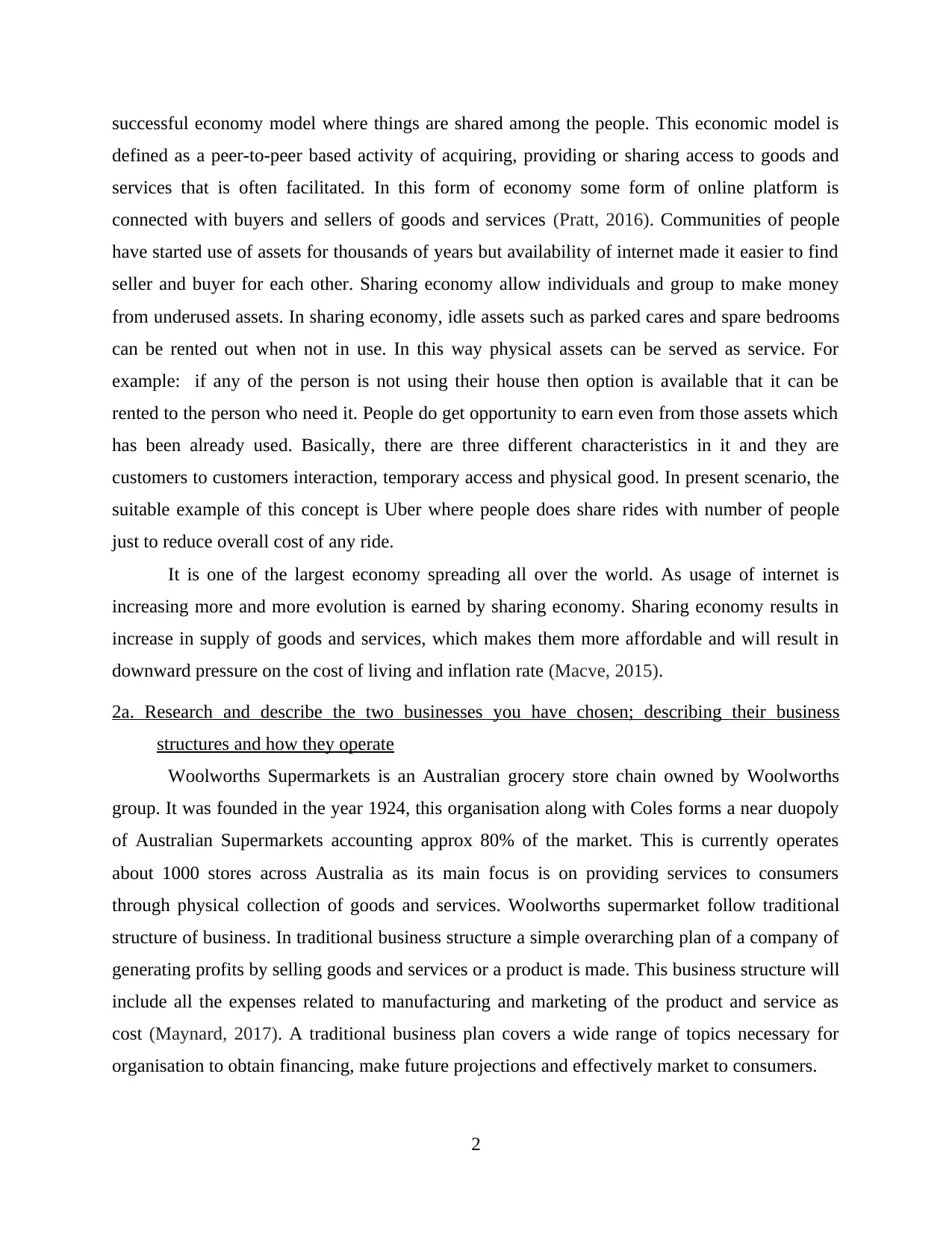
successful economy model where things are shared among the people. This economic model is
defined as a peer-to-peer based activity of acquiring, providing or sharing access to goods and
services that is often facilitated. In this form of economy some form of online platform is
connected with buyers and sellers of goods and services (Pratt, 2016). Communities of people
have started use of assets for thousands of years but availability of internet made it easier to find
seller and buyer for each other. Sharing economy allow individuals and group to make money
from underused assets. In sharing economy, idle assets such as parked cares and spare bedrooms
can be rented out when not in use. In this way physical assets can be served as service. For
example: if any of the person is not using their house then option is available that it can be
rented to the person who need it. People do get opportunity to earn even from those assets which
has been already used. Basically, there are three different characteristics in it and they are
customers to customers interaction, temporary access and physical good. In present scenario, the
suitable example of this concept is Uber where people does share rides with number of people
just to reduce overall cost of any ride.
It is one of the largest economy spreading all over the world. As usage of internet is
increasing more and more evolution is earned by sharing economy. Sharing economy results in
increase in supply of goods and services, which makes them more affordable and will result in
downward pressure on the cost of living and inflation rate (Macve, 2015).
2a. Research and describe the two businesses you have chosen; describing their business
structures and how they operate
Woolworths Supermarkets is an Australian grocery store chain owned by Woolworths
group. It was founded in the year 1924, this organisation along with Coles forms a near duopoly
of Australian Supermarkets accounting approx 80% of the market. This is currently operates
about 1000 stores across Australia as its main focus is on providing services to consumers
through physical collection of goods and services. Woolworths supermarket follow traditional
structure of business. In traditional business structure a simple overarching plan of a company of
generating profits by selling goods and services or a product is made. This business structure will
include all the expenses related to manufacturing and marketing of the product and service as
cost (Maynard, 2017). A traditional business plan covers a wide range of topics necessary for
organisation to obtain financing, make future projections and effectively market to consumers.
2
defined as a peer-to-peer based activity of acquiring, providing or sharing access to goods and
services that is often facilitated. In this form of economy some form of online platform is
connected with buyers and sellers of goods and services (Pratt, 2016). Communities of people
have started use of assets for thousands of years but availability of internet made it easier to find
seller and buyer for each other. Sharing economy allow individuals and group to make money
from underused assets. In sharing economy, idle assets such as parked cares and spare bedrooms
can be rented out when not in use. In this way physical assets can be served as service. For
example: if any of the person is not using their house then option is available that it can be
rented to the person who need it. People do get opportunity to earn even from those assets which
has been already used. Basically, there are three different characteristics in it and they are
customers to customers interaction, temporary access and physical good. In present scenario, the
suitable example of this concept is Uber where people does share rides with number of people
just to reduce overall cost of any ride.
It is one of the largest economy spreading all over the world. As usage of internet is
increasing more and more evolution is earned by sharing economy. Sharing economy results in
increase in supply of goods and services, which makes them more affordable and will result in
downward pressure on the cost of living and inflation rate (Macve, 2015).
2a. Research and describe the two businesses you have chosen; describing their business
structures and how they operate
Woolworths Supermarkets is an Australian grocery store chain owned by Woolworths
group. It was founded in the year 1924, this organisation along with Coles forms a near duopoly
of Australian Supermarkets accounting approx 80% of the market. This is currently operates
about 1000 stores across Australia as its main focus is on providing services to consumers
through physical collection of goods and services. Woolworths supermarket follow traditional
structure of business. In traditional business structure a simple overarching plan of a company of
generating profits by selling goods and services or a product is made. This business structure will
include all the expenses related to manufacturing and marketing of the product and service as
cost (Maynard, 2017). A traditional business plan covers a wide range of topics necessary for
organisation to obtain financing, make future projections and effectively market to consumers.
2
Paraphrase This Document
Need a fresh take? Get an instant paraphrase of this document with our AI Paraphraser
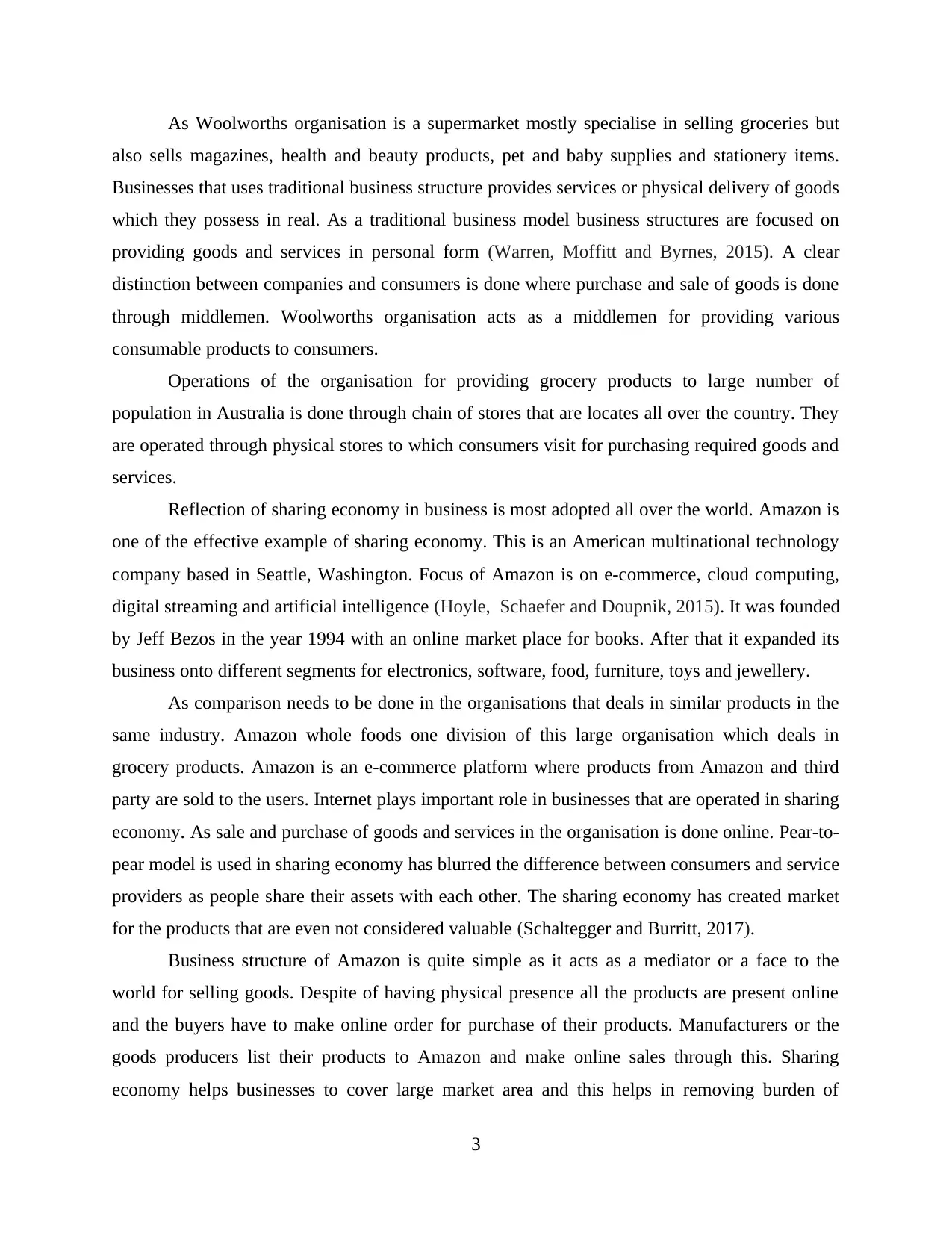
As Woolworths organisation is a supermarket mostly specialise in selling groceries but
also sells magazines, health and beauty products, pet and baby supplies and stationery items.
Businesses that uses traditional business structure provides services or physical delivery of goods
which they possess in real. As a traditional business model business structures are focused on
providing goods and services in personal form (Warren, Moffitt and Byrnes, 2015). A clear
distinction between companies and consumers is done where purchase and sale of goods is done
through middlemen. Woolworths organisation acts as a middlemen for providing various
consumable products to consumers.
Operations of the organisation for providing grocery products to large number of
population in Australia is done through chain of stores that are locates all over the country. They
are operated through physical stores to which consumers visit for purchasing required goods and
services.
Reflection of sharing economy in business is most adopted all over the world. Amazon is
one of the effective example of sharing economy. This is an American multinational technology
company based in Seattle, Washington. Focus of Amazon is on e-commerce, cloud computing,
digital streaming and artificial intelligence (Hoyle, Schaefer and Doupnik, 2015). It was founded
by Jeff Bezos in the year 1994 with an online market place for books. After that it expanded its
business onto different segments for electronics, software, food, furniture, toys and jewellery.
As comparison needs to be done in the organisations that deals in similar products in the
same industry. Amazon whole foods one division of this large organisation which deals in
grocery products. Amazon is an e-commerce platform where products from Amazon and third
party are sold to the users. Internet plays important role in businesses that are operated in sharing
economy. As sale and purchase of goods and services in the organisation is done online. Pear-to-
pear model is used in sharing economy has blurred the difference between consumers and service
providers as people share their assets with each other. The sharing economy has created market
for the products that are even not considered valuable (Schaltegger and Burritt, 2017).
Business structure of Amazon is quite simple as it acts as a mediator or a face to the
world for selling goods. Despite of having physical presence all the products are present online
and the buyers have to make online order for purchase of their products. Manufacturers or the
goods producers list their products to Amazon and make online sales through this. Sharing
economy helps businesses to cover large market area and this helps in removing burden of
3
also sells magazines, health and beauty products, pet and baby supplies and stationery items.
Businesses that uses traditional business structure provides services or physical delivery of goods
which they possess in real. As a traditional business model business structures are focused on
providing goods and services in personal form (Warren, Moffitt and Byrnes, 2015). A clear
distinction between companies and consumers is done where purchase and sale of goods is done
through middlemen. Woolworths organisation acts as a middlemen for providing various
consumable products to consumers.
Operations of the organisation for providing grocery products to large number of
population in Australia is done through chain of stores that are locates all over the country. They
are operated through physical stores to which consumers visit for purchasing required goods and
services.
Reflection of sharing economy in business is most adopted all over the world. Amazon is
one of the effective example of sharing economy. This is an American multinational technology
company based in Seattle, Washington. Focus of Amazon is on e-commerce, cloud computing,
digital streaming and artificial intelligence (Hoyle, Schaefer and Doupnik, 2015). It was founded
by Jeff Bezos in the year 1994 with an online market place for books. After that it expanded its
business onto different segments for electronics, software, food, furniture, toys and jewellery.
As comparison needs to be done in the organisations that deals in similar products in the
same industry. Amazon whole foods one division of this large organisation which deals in
grocery products. Amazon is an e-commerce platform where products from Amazon and third
party are sold to the users. Internet plays important role in businesses that are operated in sharing
economy. As sale and purchase of goods and services in the organisation is done online. Pear-to-
pear model is used in sharing economy has blurred the difference between consumers and service
providers as people share their assets with each other. The sharing economy has created market
for the products that are even not considered valuable (Schaltegger and Burritt, 2017).
Business structure of Amazon is quite simple as it acts as a mediator or a face to the
world for selling goods. Despite of having physical presence all the products are present online
and the buyers have to make online order for purchase of their products. Manufacturers or the
goods producers list their products to Amazon and make online sales through this. Sharing
economy helps businesses to cover large market area and this helps in removing burden of
3
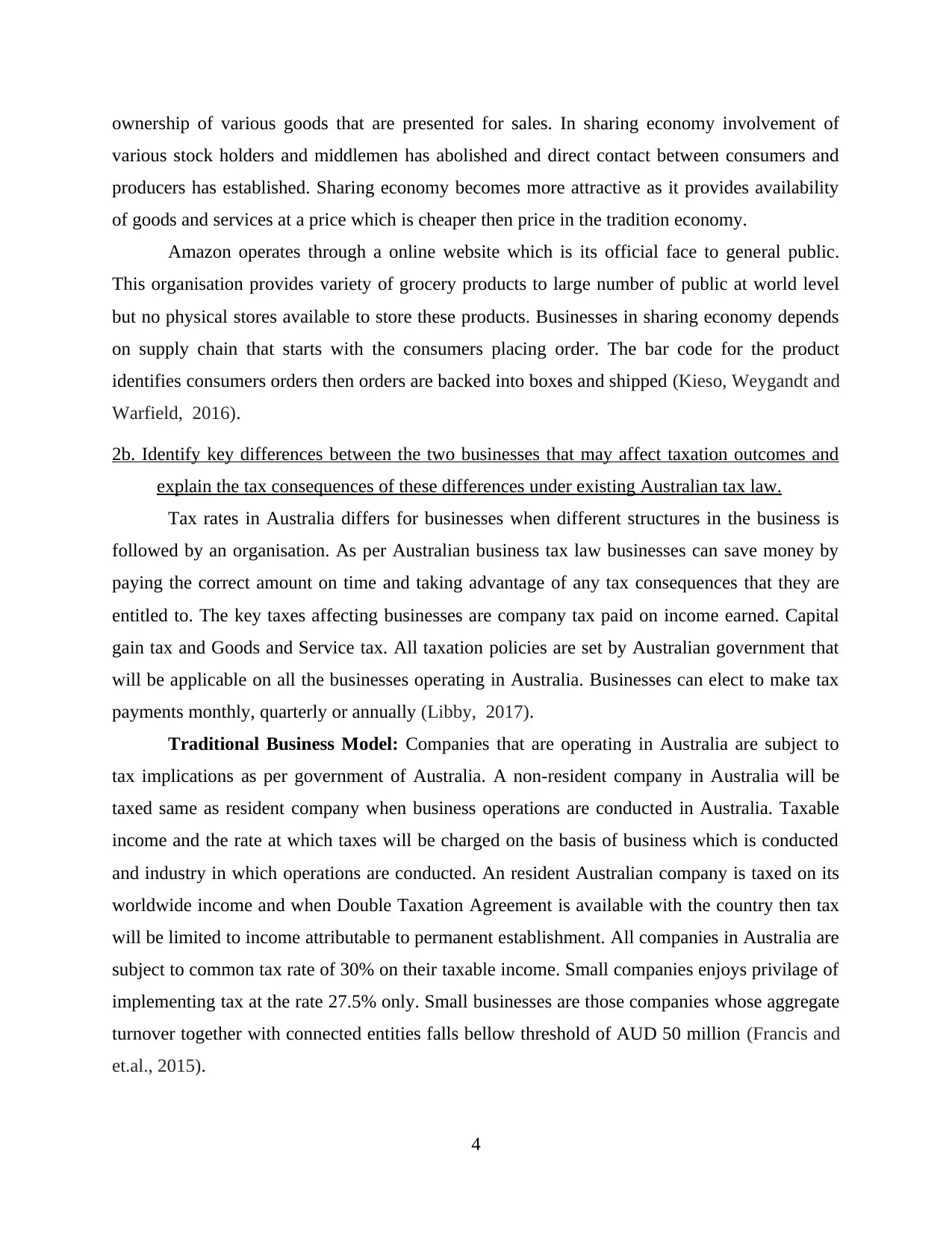
ownership of various goods that are presented for sales. In sharing economy involvement of
various stock holders and middlemen has abolished and direct contact between consumers and
producers has established. Sharing economy becomes more attractive as it provides availability
of goods and services at a price which is cheaper then price in the tradition economy.
Amazon operates through a online website which is its official face to general public.
This organisation provides variety of grocery products to large number of public at world level
but no physical stores available to store these products. Businesses in sharing economy depends
on supply chain that starts with the consumers placing order. The bar code for the product
identifies consumers orders then orders are backed into boxes and shipped (Kieso, Weygandt and
Warfield, 2016).
2b. Identify key differences between the two businesses that may affect taxation outcomes and
explain the tax consequences of these differences under existing Australian tax law.
Tax rates in Australia differs for businesses when different structures in the business is
followed by an organisation. As per Australian business tax law businesses can save money by
paying the correct amount on time and taking advantage of any tax consequences that they are
entitled to. The key taxes affecting businesses are company tax paid on income earned. Capital
gain tax and Goods and Service tax. All taxation policies are set by Australian government that
will be applicable on all the businesses operating in Australia. Businesses can elect to make tax
payments monthly, quarterly or annually (Libby, 2017).
Traditional Business Model: Companies that are operating in Australia are subject to
tax implications as per government of Australia. A non-resident company in Australia will be
taxed same as resident company when business operations are conducted in Australia. Taxable
income and the rate at which taxes will be charged on the basis of business which is conducted
and industry in which operations are conducted. An resident Australian company is taxed on its
worldwide income and when Double Taxation Agreement is available with the country then tax
will be limited to income attributable to permanent establishment. All companies in Australia are
subject to common tax rate of 30% on their taxable income. Small companies enjoys privilage of
implementing tax at the rate 27.5% only. Small businesses are those companies whose aggregate
turnover together with connected entities falls bellow threshold of AUD 50 million (Francis and
et.al., 2015).
4
various stock holders and middlemen has abolished and direct contact between consumers and
producers has established. Sharing economy becomes more attractive as it provides availability
of goods and services at a price which is cheaper then price in the tradition economy.
Amazon operates through a online website which is its official face to general public.
This organisation provides variety of grocery products to large number of public at world level
but no physical stores available to store these products. Businesses in sharing economy depends
on supply chain that starts with the consumers placing order. The bar code for the product
identifies consumers orders then orders are backed into boxes and shipped (Kieso, Weygandt and
Warfield, 2016).
2b. Identify key differences between the two businesses that may affect taxation outcomes and
explain the tax consequences of these differences under existing Australian tax law.
Tax rates in Australia differs for businesses when different structures in the business is
followed by an organisation. As per Australian business tax law businesses can save money by
paying the correct amount on time and taking advantage of any tax consequences that they are
entitled to. The key taxes affecting businesses are company tax paid on income earned. Capital
gain tax and Goods and Service tax. All taxation policies are set by Australian government that
will be applicable on all the businesses operating in Australia. Businesses can elect to make tax
payments monthly, quarterly or annually (Libby, 2017).
Traditional Business Model: Companies that are operating in Australia are subject to
tax implications as per government of Australia. A non-resident company in Australia will be
taxed same as resident company when business operations are conducted in Australia. Taxable
income and the rate at which taxes will be charged on the basis of business which is conducted
and industry in which operations are conducted. An resident Australian company is taxed on its
worldwide income and when Double Taxation Agreement is available with the country then tax
will be limited to income attributable to permanent establishment. All companies in Australia are
subject to common tax rate of 30% on their taxable income. Small companies enjoys privilage of
implementing tax at the rate 27.5% only. Small businesses are those companies whose aggregate
turnover together with connected entities falls bellow threshold of AUD 50 million (Francis and
et.al., 2015).
4
⊘ This is a preview!⊘
Do you want full access?
Subscribe today to unlock all pages.

Trusted by 1+ million students worldwide
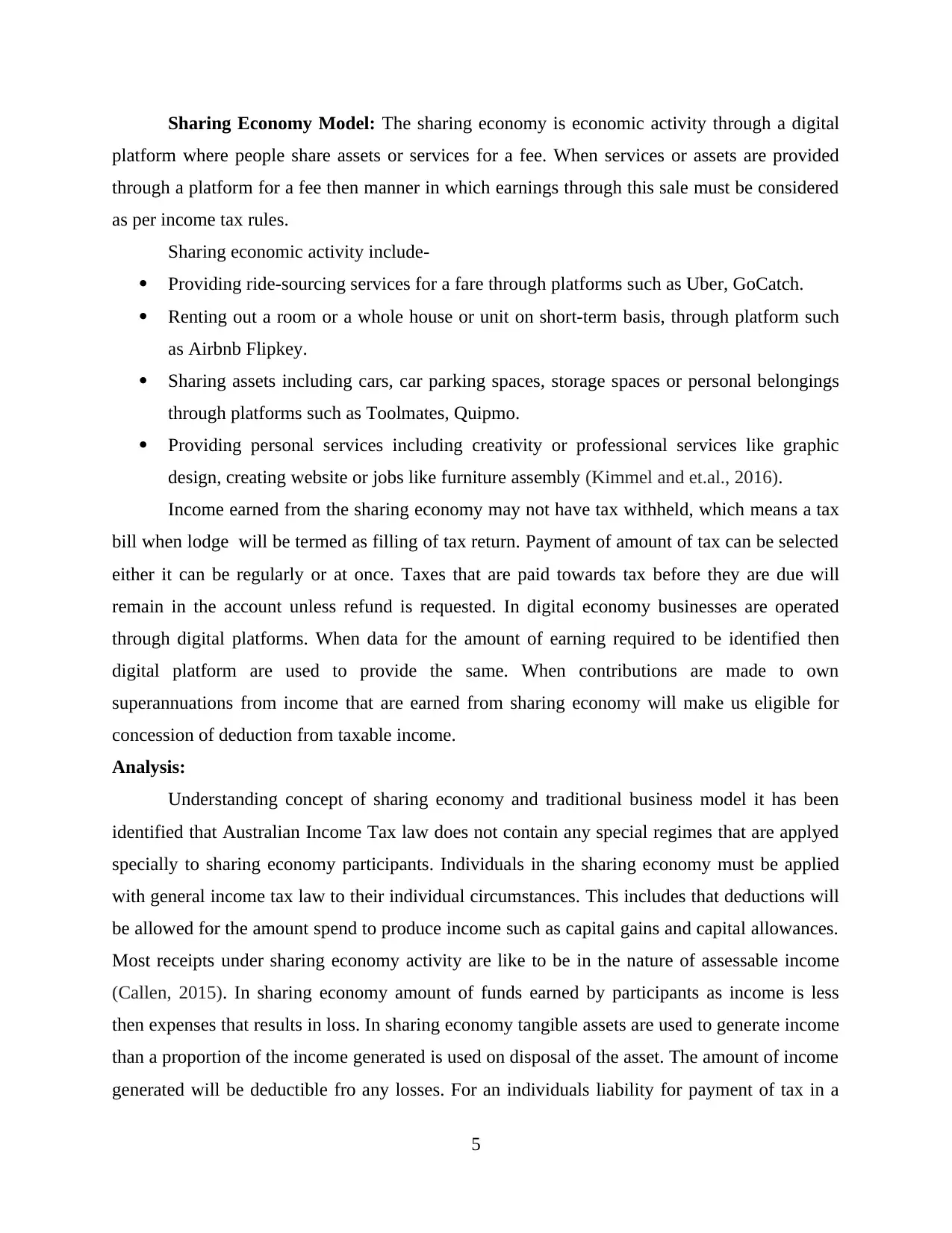
Sharing Economy Model: The sharing economy is economic activity through a digital
platform where people share assets or services for a fee. When services or assets are provided
through a platform for a fee then manner in which earnings through this sale must be considered
as per income tax rules.
Sharing economic activity include-
Providing ride-sourcing services for a fare through platforms such as Uber, GoCatch.
Renting out a room or a whole house or unit on short-term basis, through platform such
as Airbnb Flipkey.
Sharing assets including cars, car parking spaces, storage spaces or personal belongings
through platforms such as Toolmates, Quipmo.
Providing personal services including creativity or professional services like graphic
design, creating website or jobs like furniture assembly (Kimmel and et.al., 2016).
Income earned from the sharing economy may not have tax withheld, which means a tax
bill when lodge will be termed as filling of tax return. Payment of amount of tax can be selected
either it can be regularly or at once. Taxes that are paid towards tax before they are due will
remain in the account unless refund is requested. In digital economy businesses are operated
through digital platforms. When data for the amount of earning required to be identified then
digital platform are used to provide the same. When contributions are made to own
superannuations from income that are earned from sharing economy will make us eligible for
concession of deduction from taxable income.
Analysis:
Understanding concept of sharing economy and traditional business model it has been
identified that Australian Income Tax law does not contain any special regimes that are applyed
specially to sharing economy participants. Individuals in the sharing economy must be applied
with general income tax law to their individual circumstances. This includes that deductions will
be allowed for the amount spend to produce income such as capital gains and capital allowances.
Most receipts under sharing economy activity are like to be in the nature of assessable income
(Callen, 2015). In sharing economy amount of funds earned by participants as income is less
then expenses that results in loss. In sharing economy tangible assets are used to generate income
than a proportion of the income generated is used on disposal of the asset. The amount of income
generated will be deductible fro any losses. For an individuals liability for payment of tax in a
5
platform where people share assets or services for a fee. When services or assets are provided
through a platform for a fee then manner in which earnings through this sale must be considered
as per income tax rules.
Sharing economic activity include-
Providing ride-sourcing services for a fare through platforms such as Uber, GoCatch.
Renting out a room or a whole house or unit on short-term basis, through platform such
as Airbnb Flipkey.
Sharing assets including cars, car parking spaces, storage spaces or personal belongings
through platforms such as Toolmates, Quipmo.
Providing personal services including creativity or professional services like graphic
design, creating website or jobs like furniture assembly (Kimmel and et.al., 2016).
Income earned from the sharing economy may not have tax withheld, which means a tax
bill when lodge will be termed as filling of tax return. Payment of amount of tax can be selected
either it can be regularly or at once. Taxes that are paid towards tax before they are due will
remain in the account unless refund is requested. In digital economy businesses are operated
through digital platforms. When data for the amount of earning required to be identified then
digital platform are used to provide the same. When contributions are made to own
superannuations from income that are earned from sharing economy will make us eligible for
concession of deduction from taxable income.
Analysis:
Understanding concept of sharing economy and traditional business model it has been
identified that Australian Income Tax law does not contain any special regimes that are applyed
specially to sharing economy participants. Individuals in the sharing economy must be applied
with general income tax law to their individual circumstances. This includes that deductions will
be allowed for the amount spend to produce income such as capital gains and capital allowances.
Most receipts under sharing economy activity are like to be in the nature of assessable income
(Callen, 2015). In sharing economy amount of funds earned by participants as income is less
then expenses that results in loss. In sharing economy tangible assets are used to generate income
than a proportion of the income generated is used on disposal of the asset. The amount of income
generated will be deductible fro any losses. For an individuals liability for payment of tax in a
5
Paraphrase This Document
Need a fresh take? Get an instant paraphrase of this document with our AI Paraphraser
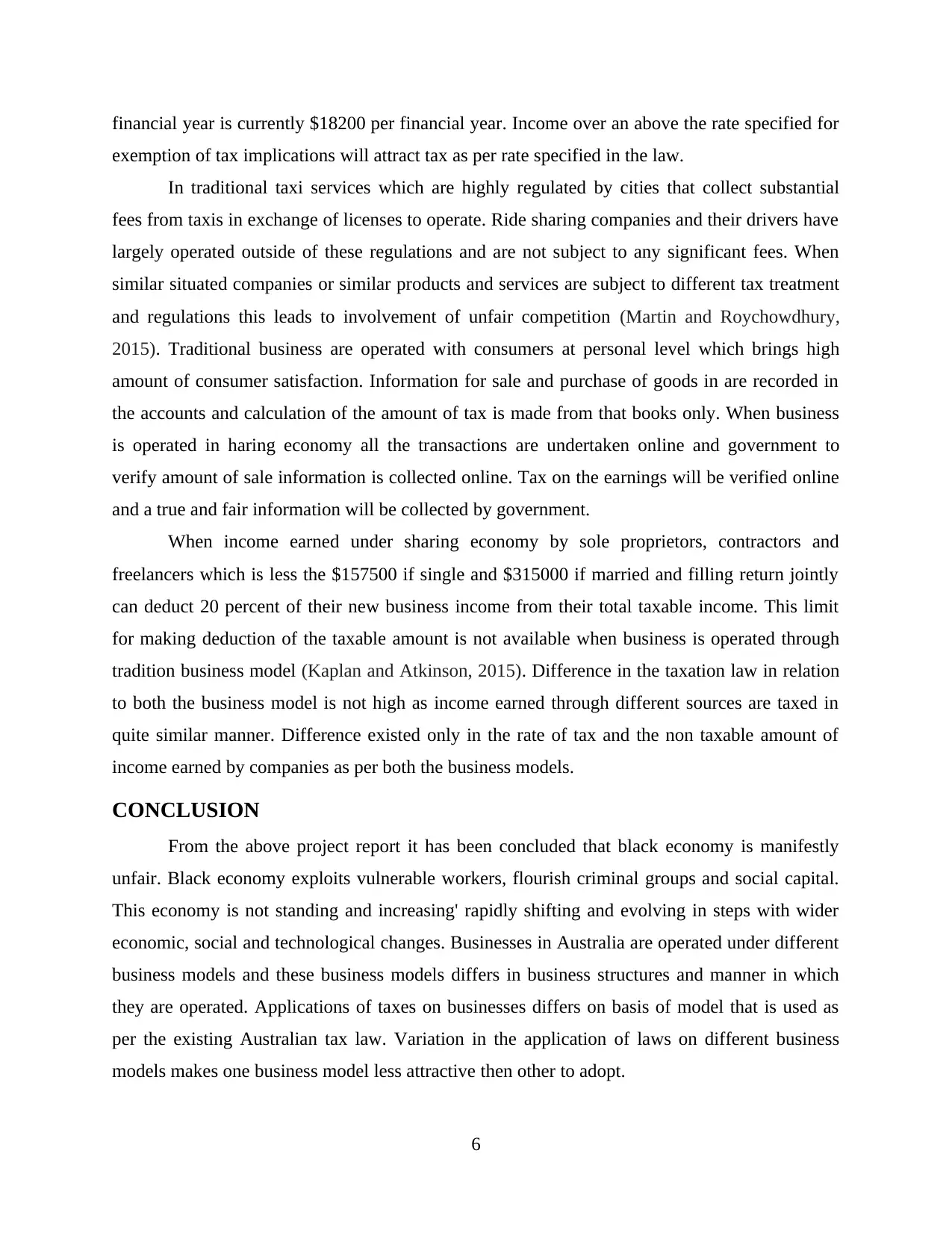
financial year is currently $18200 per financial year. Income over an above the rate specified for
exemption of tax implications will attract tax as per rate specified in the law.
In traditional taxi services which are highly regulated by cities that collect substantial
fees from taxis in exchange of licenses to operate. Ride sharing companies and their drivers have
largely operated outside of these regulations and are not subject to any significant fees. When
similar situated companies or similar products and services are subject to different tax treatment
and regulations this leads to involvement of unfair competition (Martin and Roychowdhury,
2015). Traditional business are operated with consumers at personal level which brings high
amount of consumer satisfaction. Information for sale and purchase of goods in are recorded in
the accounts and calculation of the amount of tax is made from that books only. When business
is operated in haring economy all the transactions are undertaken online and government to
verify amount of sale information is collected online. Tax on the earnings will be verified online
and a true and fair information will be collected by government.
When income earned under sharing economy by sole proprietors, contractors and
freelancers which is less the $157500 if single and $315000 if married and filling return jointly
can deduct 20 percent of their new business income from their total taxable income. This limit
for making deduction of the taxable amount is not available when business is operated through
tradition business model (Kaplan and Atkinson, 2015). Difference in the taxation law in relation
to both the business model is not high as income earned through different sources are taxed in
quite similar manner. Difference existed only in the rate of tax and the non taxable amount of
income earned by companies as per both the business models.
CONCLUSION
From the above project report it has been concluded that black economy is manifestly
unfair. Black economy exploits vulnerable workers, flourish criminal groups and social capital.
This economy is not standing and increasing' rapidly shifting and evolving in steps with wider
economic, social and technological changes. Businesses in Australia are operated under different
business models and these business models differs in business structures and manner in which
they are operated. Applications of taxes on businesses differs on basis of model that is used as
per the existing Australian tax law. Variation in the application of laws on different business
models makes one business model less attractive then other to adopt.
6
exemption of tax implications will attract tax as per rate specified in the law.
In traditional taxi services which are highly regulated by cities that collect substantial
fees from taxis in exchange of licenses to operate. Ride sharing companies and their drivers have
largely operated outside of these regulations and are not subject to any significant fees. When
similar situated companies or similar products and services are subject to different tax treatment
and regulations this leads to involvement of unfair competition (Martin and Roychowdhury,
2015). Traditional business are operated with consumers at personal level which brings high
amount of consumer satisfaction. Information for sale and purchase of goods in are recorded in
the accounts and calculation of the amount of tax is made from that books only. When business
is operated in haring economy all the transactions are undertaken online and government to
verify amount of sale information is collected online. Tax on the earnings will be verified online
and a true and fair information will be collected by government.
When income earned under sharing economy by sole proprietors, contractors and
freelancers which is less the $157500 if single and $315000 if married and filling return jointly
can deduct 20 percent of their new business income from their total taxable income. This limit
for making deduction of the taxable amount is not available when business is operated through
tradition business model (Kaplan and Atkinson, 2015). Difference in the taxation law in relation
to both the business model is not high as income earned through different sources are taxed in
quite similar manner. Difference existed only in the rate of tax and the non taxable amount of
income earned by companies as per both the business models.
CONCLUSION
From the above project report it has been concluded that black economy is manifestly
unfair. Black economy exploits vulnerable workers, flourish criminal groups and social capital.
This economy is not standing and increasing' rapidly shifting and evolving in steps with wider
economic, social and technological changes. Businesses in Australia are operated under different
business models and these business models differs in business structures and manner in which
they are operated. Applications of taxes on businesses differs on basis of model that is used as
per the existing Australian tax law. Variation in the application of laws on different business
models makes one business model less attractive then other to adopt.
6

7
⊘ This is a preview!⊘
Do you want full access?
Subscribe today to unlock all pages.

Trusted by 1+ million students worldwide
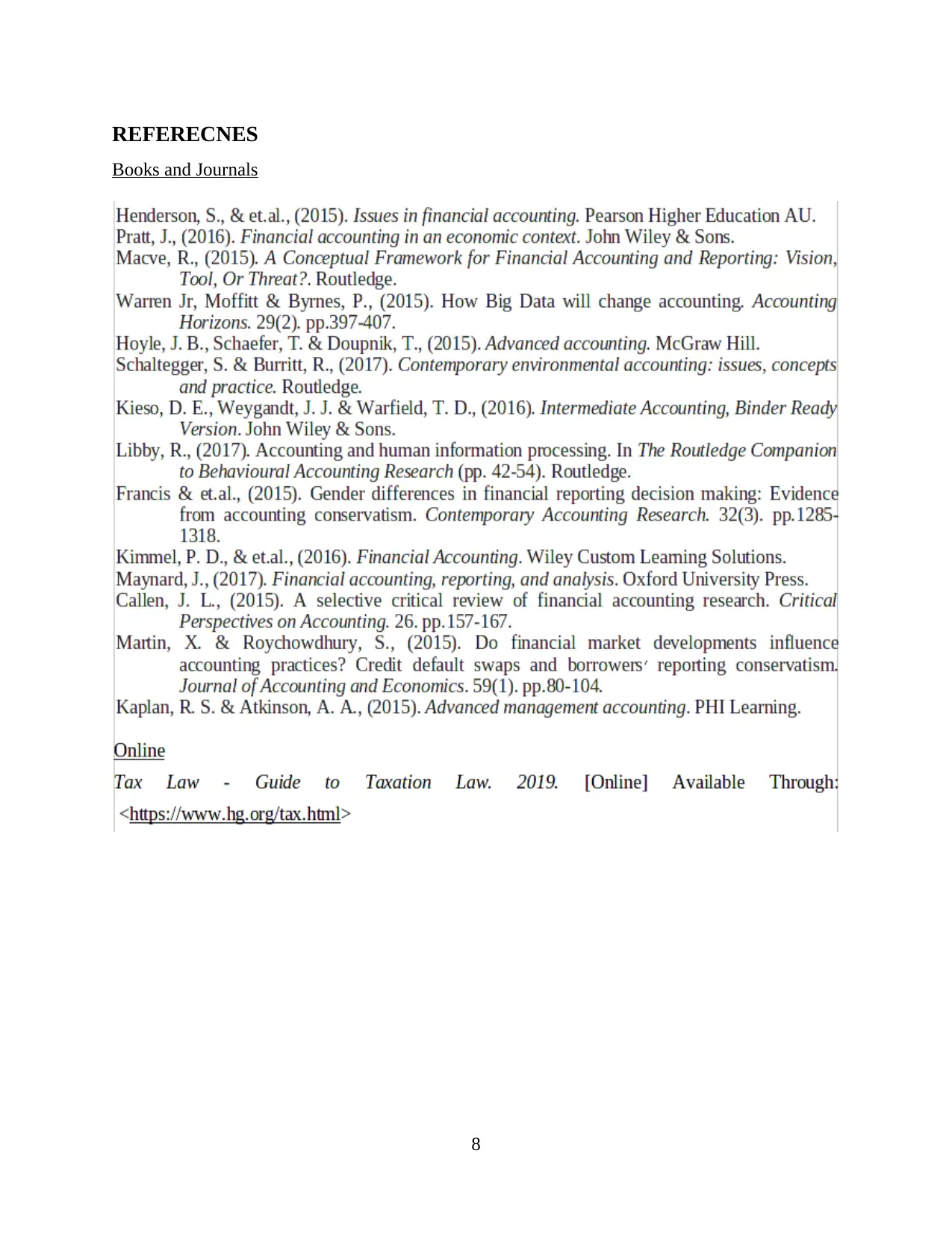
REFERECNES
Books and Journals
8
Books and Journals
8
1 out of 10
Related Documents
Your All-in-One AI-Powered Toolkit for Academic Success.
+13062052269
info@desklib.com
Available 24*7 on WhatsApp / Email
![[object Object]](/_next/static/media/star-bottom.7253800d.svg)
Unlock your academic potential
Copyright © 2020–2025 A2Z Services. All Rights Reserved. Developed and managed by ZUCOL.





